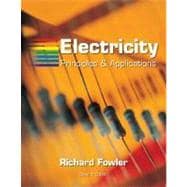
What is included with this book?
| Electricity: Principles And Applications 7/e | |
| Basic Concepts | |
| Work and Energy | |
| Unit of Energy | |
| Energy Conversion | |
| Efficiency | |
| Structure of Matter | |
| Electric Charge | |
| Valence Electrons | |
| Free Electrons | |
| Ions | |
| Static Charge and Static Electricity | |
| Static Discharge | |
| Uses of Static Electricity | |
| Electrical Quantities and Units | |
| Charge | |
| Unit of Charge | |
| Current and Current Carriers | |
| Current in Solids | |
| Current in Liquids and Gases | |
| Current in a Vacuum | |
| Unit of Current—The Ampere | |
| Voltage | |
| Unit of Voltage—The Volt | |
| Polarity | |
| Sources of Voltage | |
| Resistance | |
| Conductors | |
| Insulators | |
| Semiconductors | |
| Unit of Resistance—The Ohm | |
| Temperature Coefficient | |
| Resistivity | |
| Resistors | |
| Power and Energy | |
| Unit of Power | |
| Efficiency | |
| Powers of 10 | |
| Multiple and Submultiple Units | |
| Special Units and Conversions | |
| Basic Circuits, Laws, and Measurements>h4> | |
| Circuit Essentials | |
| Circuit Symbols and Diagrams | |
| Calculating Electrical Quantities | |
| Measuring Electrical Quantities | |
| Circuit Components | |
| Batteries and Cells | |
| Lead-Acid Cells | |
| Nickel-Cadmium Cells | |
| Carbon-Zinc and Zinc Chloride Cells | |
| Alkaline-Manganese Dioxide Cells | |
| Mercuric Oxide Cells | |
| Silver Oxide Cells | |
| Lithium Cells>h4>4-9 Miniature Lamps and LEDs | |
| Resistors | |
| Switches | |
| Wires and Cables | |
| Fuses and Circuit Breakers | |
| Other Components | |
| Multiple-Load Circuits | |
| Subscripts | |
| Power in Multiple-Load Circuits | |
| Series Circuits | |
| Maximum Power Transfer | |
| Parallel Circuits | |
| Conductance | |
| Series-Parallel Circuits | |
| Voltage Dividers and Regulators | |
| Complex-Circuit Analysis | |
| Simultaneous Equations | |
| Loop-Equations Technique | |
| Node Voltage Technique | |
| Superposition Theorem | |
| Voltage Sources | |
| Thevenin’s Theorem | |
| Current Source | |
| Norton’s Theorem | |
| Comparison of Techniques | |
| Magnetism and Electromagnetism | |
| Magnetism and Magnets | |
| Magnetic Fields, Flux, and Poles | |
| Electromagnetism | |
| Magnetic Materials | |
| Magnetizing Magnetic Materials | |
| Magnetomotive Force | |
| Saturation | |
| Demagnetizing | |
| Residual Magnetism | |
| Reluctance | |
| Magnetic Shields | |
| Induced Voltage | |
| Magnetic Quantities and Units | |
| Electromagnets | |
| DC Motors | |
| Solenoids | |
| Relays | |
| Hall-Effect Devices | |
| Alternating Current and Voltage | |
| AC Terminology | |
| Waveforms | |
| Types of AC Waveforms | |
| Quantifying Alternating Current | |
| The Sine Wave | |
| AC Generator | |
| Advantages of Alternating Current | |
| Three-Phase Alternating Current | |
| Power in AC Circuits | |
| Power in Resistive AC Circuits | |
| Power in Out-Of-Phase Circuits | |
| True Power and Apparent Power | |
| Power Factor | |
| Capacitance | |
| Terminology | |
| Basic Capacitor Action | |
| Voltage Rating | |
| Unit of Capacitance | |
| Determining Capacitance | |
| Types of Capacitors | |
| Schematic Symbols | |
| Capacitors in DC Circuits | |
| Capacitors in AC Circuits | |
| Capacitors in Series | |
| Capacitors in Parallel | |
| Detecting Faulty Capacitors | |
| Undesired, or Stray, Capacitance | |
| Capacitor Specifications | |
| Uses of Capacitors | |
| Inductance | |
| Characteristics of Inductance | |
| Unit of Inductance—The Henry | |
| Factors of Determining Inductance | |
| Types of Inductors | |
| Ratings of Inductors | |
| Inductors in DC Circuits | |
| Ideal Inductors in AC Circ | |
| Table of Contents provided by Publisher. All Rights Reserved. |
The New copy of this book will include any supplemental materials advertised. Please check the title of the book to determine if it should include any access cards, study guides, lab manuals, CDs, etc.
The Used, Rental and eBook copies of this book are not guaranteed to include any supplemental materials. Typically, only the book itself is included. This is true even if the title states it includes any access cards, study guides, lab manuals, CDs, etc.